太阳系最高山峰列表
以下为太阳系各星球上已知的最高山峰列表,羅列星球上的各類型之最高峰。位於火星上高达22公里的盾状火山-奥林帕斯山是太阳系所有行星中的最高山峰。在1971年它被发现之后的40年中,奥林帕斯山一直是太阳系中已知的最高峰。 然而在2011年发现小行星灶神星的雷亚希尔维亚盆地的中央峰具有與其相仿的高度。[lower-alpha 1]
列表
以下高度为从底部到顶部的距离,因为在其他星球没有与地球对等的海平面可供测量。
| 星球 | 最高峰 | 高度 | 发源 | 注释 |
|---|---|---|---|---|
| 水星 | 卡洛里山脉 | 3 km[1][2] | 撞击坑[3] | 由卡洛里撞击形成 |
| 金星 | 馬克士威山脈 | 6.4 km(4.0 mi) [4] | 构造山[5] | 具有被称为「金星之雪」的明亮雷达影像区域,可能是因为黄铁矿等矿物存在造成的[6] |
| 马特山 | 4.9 km(3.0 mi)[7] | 火山[8] | 金星上最高的火山 | |
| 地球 | 冒纳凯阿火山 和 冒纳罗亚火山 | 10.2 km(6.3 mi)[9] | 火山 | 地球上底部到顶部最高的山,露出海平面仅有4.2 km(2.6 mi) |
| 泰德峰 | 7.5km[10] | 火山 | 露出海平面仅有3.7 km(2.3 mi) | |
| 迪纳利峰 | 6.9km[11] | 构造山 | 地面上底部到顶部最高的山,相对高度超过6000米[12][lower-alpha 2] | |
| 珠穆朗玛峰 | 8.8 km | 构造山 | 北坡高4.6 km,南坡高3.6 km[lower-alpha 3] | |
| 钦博拉索山 | 6.3km | 构造山 | 地球上距离地心最远的一点 | |
| 月球 | 惠更斯山 | 5.5 km(3.4 mi)[13][14] | 撞击坑 | 由雨海撞击形成 |
| 哈德利山 | 4.5 km(2.8 mi)[13][14] | 撞击坑 | 由雨海撞击形成 | |
| 吕姆克山 | 1.1 km(0.68 mi)[15] | 火山 | 月球上最大的火山结构[15] | |
| 火星 | 奥林帕斯山 | 26 km(16 mi)[16][17] | 火山 | Rises 26 km above northern plains,[18] 1000 km away. |
| 艾斯克雷尔斯山 | 14.9 km(9.3 mi)[16] | 火山 | 塔尔西斯山群三座山之中最高者 | |
| 埃律西昂山 | 12.6 km(7.8 mi)[16] | 火山 | 埃律西昂平原最高的火山 | |
| 阿尔西亚山 | 11.7 km(7.3 mi)[16] | 火山 | Summit caldera is 108至138 km(67至86 mi) across[16] | |
| 帕弗尼斯山 | 8.4 km(5.2 mi)[16] | 火山 | Summit caldera is 4.8 km(3.0 mi) deep[16] | |
| 安瑟里斯山 | 6.2 km(3.9 mi)[19] | 撞击坑 | 火星上最高的非火山,由希腊撞击形成 | |
| 夏普山 | 4.5至5.5 km(2.8至3.4 mi)[20][lower-alpha 4] | 侵蚀作用[22] | Formed from deposits in Gale crater; to be ascended by the MSL rover[23] | |
| 灶神星 | 雷亚希尔维亚中央峰 | 22 km(14 mi)[24][25] | 撞击坑 | 太阳系最大撞击坑列表 |
| 木卫一 | Boösaule Montes "South"[26] | 17.5至18.2 km(10.9至11.3 mi)[27] | 构造山 | Has a 15 km(9 mi) high scarp on its SE margin[28] |
| 爱奥尼亚山东脊 | 12.7 km(7.9 mi)[28][29] | 构造山 | Has the form of a curved double ridge | |
| 优卑亚山 | 10.3至13.4 km(6.4至8.3 mi)[30] | 构造山 | A NW flank landslide left a 25,000 km3 debris apron[31][lower-alpha 5] | |
| 在(245° W, 30° S) | 2.5 km(1.6 mi)[32][33] | 火山 | 木卫一的最高火山之一,拥有非典型的圆锥形。[33][lower-alpha 6] | |
| 土卫一 | 赫歇尔撞击坑中央峰 | 7 km(4 mi)[35] | 撞击坑 | 太阳系最大撞击坑列表 |
| 土衛六 | 米斯林山脉 | 2.0 km(1.2 mi)[36] | 构造山 | May have formed due to global contraction[36] |
| 末日山 | 1.45 km(0.90 mi)[37] | 冰火山 | 与索特拉光斑相邻 | |
| 土卫八 | 赤道脊 | 20 km(12 mi)[38] | [lower-alpha 7] | 各別的山峰高度仍待測量 |
| 天卫四 | limb mountain | 11 km(7 mi)[35] | 撞击坑 | 由旅行者2号飞掠,简单地测定为6公里[42] |
相册
以下图片以高度降序排列:

 Olympus Mons on Mars as viewed from 維京1號 in 1978
Olympus Mons on Mars as viewed from 維京1號 in 1978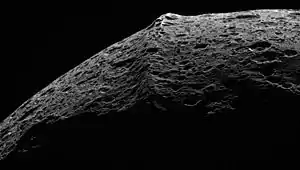 Cassini image of Iapetus's equatorial ridge
Cassini image of Iapetus's equatorial ridge Voyager 1 photo of Io's highest peak, Boösaule Montes "South"
Voyager 1 photo of Io's highest peak, Boösaule Montes "South" Ascraeus Mons (THEMIS IR with MOLA altimetry, 3x vertical stretch), Mars
Ascraeus Mons (THEMIS IR with MOLA altimetry, 3x vertical stretch), Mars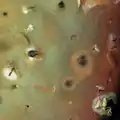 Io's Euboea Montes (below top left), Haemus Montes (lower right); north is left
Io's Euboea Montes (below top left), Haemus Montes (lower right); north is left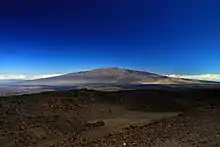
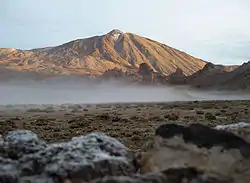 Teide, Canary Islands
Teide, Canary Islands Cassini photo of Herschel crater on Mimas and its central peak
Cassini photo of Herschel crater on Mimas and its central peak Magellan radar image of Venus's Maxwell Montes
Magellan radar image of Venus's Maxwell Montes Mt. McKinley (Denali), Alaska
Mt. McKinley (Denali), Alaska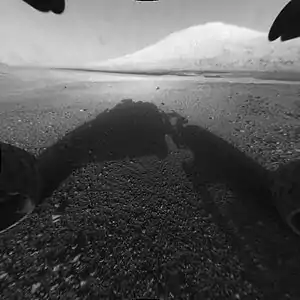 Aeolis Mons ("Mount Sharp"), Mars (as viewed by the rover Curiosity on August 6, 2012).[lower-alpha 8]
Aeolis Mons ("Mount Sharp"), Mars (as viewed by the rover Curiosity on August 6, 2012).[lower-alpha 8]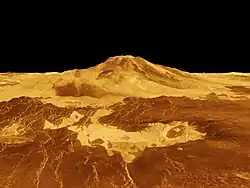 Maat Mons, Venus (radar imaging plus altimetry, 10x vertical exaggeration)
Maat Mons, Venus (radar imaging plus altimetry, 10x vertical exaggeration)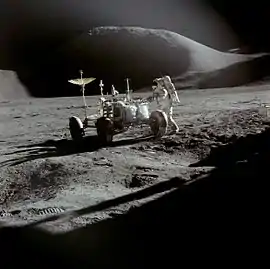 The Moon's Mons Hadley, near the Apollo 15 landing site (1971)
The Moon's Mons Hadley, near the Apollo 15 landing site (1971) Mt. Everest (Chomolungma/ Sagarmāthā), China/Nepal
Mt. Everest (Chomolungma/ Sagarmāthā), China/Nepal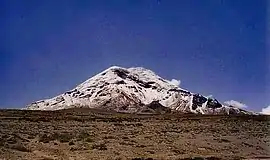 Chimborazo, 厄瓜多尔
Chimborazo, 厄瓜多尔
注释
- Olympus Mons, however, is a much broader peak; its diameter exceeds that of Vesta itself.
- On p. 20 of Helman (2005): "the base to peak rise of Mount McKinley is the largest of any mountain that lies entirely above sea level, some 18000 feet"
- Peak is 8.8 km(5.5 mi) above sea level, and over 13 km(8.1 mi) above the oceanic abyssal plain.
- About 5.25 km high from the perspective of the landing site of Curiosity.[21]
- Among the Solar System's largest[31]
- Some of Io's paterae are surrounded by radial patterns of lava flows, indicating they are on a topographic high point, making them shield volcanoes. Most of these volcanoes exhibit relief of less than 1 km. A few have more relief; Ruwa Patera rises 2.5 to 3 km over its 300 km width. However, its slopes are only on the order of a degree.[34] A handful of Io's smaller shield volcanoes have steeper, conical profiles; the example listed is 60 km across and has slopes averaging 4° and reaching 6-7° approaching the small summit depression.[34]
- Hypotheses of origin include crustal readjustment associated with a decrease in oblateness due to tidal locking,[39][40] and deposition of deorbiting material from a former ring around the moon.[41]
- A linearized wide-angle hazcam image that makes the mountain look steeper than it actually is.
参考资料
- . MESSENGER web site. Johns Hopkins University/Applied Physics Lab. [2012-04-04]. (原始内容存档于2016-09-30).
- Oberst, J.; Preusker, F.; Phillips, R. J.; Watters, T. R.; Head, J. W.; Zuber, M. T.; Solomon, S. C. . Icarus. 2010, 209 (1): 230–238. ISSN 0019-1035. doi:10.1016/j.icarus.2010.03.009.
- Fassett, C. I.; Head, J. W.; Blewett, D. T.; Chapman, C. R.; Dickson, J. L.; Murchie, S. L.; Solomon, S. C.; Watters, T. R. . Earth and Planetary Science Letters. 2009, 285 (3-4): 297–308. ISSN 0012-821X. doi:10.1016/j.epsl.2009.05.022.
- Jones, Tom; Stofan, Ellen. . Washington, D.C.: National Geographic Society. 2008: 74 [2013-04-13]. ISBN 978-1-4262-0121-9. (原始内容存档于2014-01-02).
- Keep, M.; Hansen, V. L. . Journal of Geophysical Research. 1994, 99 (E12): 26015. ISSN 0148-0227. doi:10.1029/94JE02636.
- Otten, Carolyn Jones. . Newsroom (Washington University in Saint Louis). 2004-02-10 [2012-12-10]. (原始内容存档于2016-01-29).
- . Planetary Photojournal. Jet Propulsion Lab. 1996-08-01 [2012-06-30]. (原始内容存档于2016-03-08).
- Robinson, C. A.; Thornhill, G. D.; Parfitt, E. A. . Journal of Geophysical Research. 1995-01, 100 (E6): 11755–11764 [2013-02-11]. Bibcode:1995JGR...10011755R. doi:10.1029/95JE00147. (原始内容存档于2012-03-01).
- . National Geographic Society. [September 19, 2010]. (原始内容存档于2016-03-04).
- . UNESCO World Heritage Site list. UNESCO. [2 June 2013]. (原始内容存档于2018-12-24).
- . NOVA. Public Broadcasting Corporation. 2000 [June 7, 2007]. (原始内容存档于2016-03-03).
- Adam Helman. . Trafford Publishing. 2005 [2012-12-09]. ISBN 978-1-4120-5995-4.
- Fred W. Price. . London: Cambridge University Press. 1988. ISBN 0-521-33500-0.
- Moore, Patrick. . London: Cassell & Co. 2001.
- Wöhler, C.; Lena, R.; Pau, K. C. . . League City, Texas: Dordrecht, D. Reidel Publishing Co. March 12–16, 2007 [2007-08-28]. (原始内容存档于2020-07-07).
- Plescia, J. B. . Journal of Geophysical Research. 2004, 109 (E3). ISSN 0148-0227. doi:10.1029/2002JE002031.
- Carr, M.H., 2006, The Surface of Mars, Cambridge, 307 p.
- Comins, Neil F. . Macmillan. 4 January 2012 [23 December 2012]. ISBN 978-1-4292-5519-6. (原始内容存档于2014-09-21).
- JMARS MOLA elevation dataset. Christensen, P.; Gorelick, N.; Anwar, S.; Dickenshied, S.; Edwards, C.; Engle, E. (2007) "New Insights About Mars From the Creation and Analysis of Mars Global Datasets 页面存档备份,存于;" American Geophysical Union, Fall Meeting, abstract #P11E-01.
- . Mars Odyssey THEMIS web site. Arizona State University. [2012-12-07]. (原始内容存档于2008-11-04).
- Anderson, R. B.; Bell III, J. F. . International Journal of Mars Science and Exploration. 2010, 5: 76–128 [2013-04-13]. Bibcode:2010IJMSE...5...76A. doi:10.1555/mars.2010.0004. (原始内容存档于2019-06-07).
- A crater central peak is thought to sit below the mound of sediment. Gale crater may have once been entirely filled by sediment before erosional processes gained the upper hand over deposition.
- Agle, D. C. . NASA. 28 March 2012 [31 March 2012]. (原始内容存档于2016-03-03).
- Vega, P. . Jet Propulsion Lab's Dawn mission web site. NASA. 11 October 2011 [29 March 2012]. (原始内容存档于2011年10月22日).
- Schenk, P.; Marchi, S.; O'Brien, D.P.; Buczkowski, D.; Jaumann, R.; Yingst, A.; McCord, T.; Gaskell, R.; Roatsch, T.; Keller, H. E.; Raymond, C.A.; Russell, C.T. . . The Woodlands, Texas: LPI. 2012-03 [2012-09-06]. contribution 1659, id.2757. (原始内容存档于2018-10-05).
- Perry, Jason. . Gish Bar Times blog. 2009-01-27 [2012-06-30]. (原始内容存档于2016-03-23).
- Schenk, P.; Hargitai, H. . Io Mountain Database. [2012-06-30]. (原始内容存档于2016-03-04).
- Schenk, Paul; Hargitai, Henrik; Wilson, Ronda; McEwen, Alfred; Thomas, Peter. . Journal of Geophysical Research. 2001, 106 (E12): 33201. ISSN 0148-0227. doi:10.1029/2000JE001408.
- Schenk, P.; Hargitai, H. . Io Mountain Database. [2012-06-30]. (原始内容存档于2016-03-04).
- Schenk, P.; Hargitai, H. . Io Mountain Database. [2012-06-30]. (原始内容存档于2016-03-04).
- Martel, L. M. V. . NASA Solar System Exploration web site. 2011-02-16 [2012-06-30]. (原始内容存档于2011-01-13).
- Moore, J. M.; McEwen, A. S.; Albin, E. F.; Greeley, R. . Icarus. 1986, 67 (1): 181–183. ISSN 0019-1035. doi:10.1016/0019-1035(86)90183-1.
- Schenk, P.; Hargitai, H. . Io Mountain Database. [2012-12-06]. (原始内容存档于2016-03-04).
- Schenk, P. M.; Wilson, R. R.; Davies, R. G. . Icarus. 2004, 169 (1): 98–110. Bibcode:2004Icar..169...98S. doi:10.1016/j.icarus.2004.01.015.
- Jeffrey M. Moore, Paul M. Schenk, Lindsey S. Bruesch, Erik Asphaug, William B. McKinnon. . Icarus: 421–443. [2018-04-02]. doi:10.1016/j.icarus.2004.05.009. (原始内容存档于2018-07-02).
- Mitri, G.; Bland,M. T.; Showman, A. P.; Radebaugh, J.; Stiles, B.; Lopes, R. M. C.; Lunine, J. I.; Pappalardo, R. T. . Journal of Geophysical Research. 2010, 115 (E10002): 1–15 [2012-07-05]. Bibcode:2010JGRE..11510002M. doi:10.1029/2010JE003592. (原始内容存档于2020-01-26).
- Lopes, R. M. C.; Kirk, R. L.; Mitchell, K. L.; LeGall, A.; Barnes, J. W.; Hayes, A.; Kargel, J.; Wye, L.; Radebaugh, J.; Stofan, E. R.; Janssen, M. A.; Neish, C. D.; Wall, S. D.; Wood, C. A.; Lunine, J. I.; Malaska, M. J. . Journal of Geophysical Research: Planets. 2013-03-19, 118: 1–20 [2013-04-10]. doi:10.1002/jgre.20062. (原始内容存档于2015-11-26).
- Giese, B.; Denk, T.; Neukum, G.; Roatsch, T.; Helfenstein, P.; Thomas, P. C.; Turtle, E. P.; McEwen, A.; Porco, C. C. (PDF). Icarus. 2008, 193 (2): 359–371 [2013-04-13]. ISSN 0019-1035. doi:10.1016/j.icarus.2007.06.005. (原始内容存档于2020-03-13).
- Porco, C. C.; et al.. . Science. 2005, 307 (5713): 1237–1242. ISSN 0036-8075. PMID 15731440. doi:10.1126/science.1107981. 2005Sci...307.1237P.
- Kerr, Richard A. . Science. 2006-01-06, 311 (5757): 29 [2013-04-13]. PMID 16400121. doi:10.1126/science.311.5757.29. (原始内容存档于2008-08-07).
- Ip, W.-H. (PDF). Geophysical Research Letters. 2006, 33 (16): L16203 [2013-04-13]. ISSN 0094-8276. doi:10.1029/2005GL025386. (原始内容 (PDF)存档于2019-06-26).
- Moore, P.; Henbest, N. . Journal of the British Astronomical Association. 1986-04, 96 (3): 131–137 [2012-07-07]. Bibcode:1986JBAA...96..131M. (原始内容存档于2018-10-05).
外部链接
- High resolution side view color image of Rheasilvia's central peak 页面存档备份,存于 at Planetary.org 页面存档备份,存于 (peak is at upper right)
- Color mosaic of Vesta's southern hemisphere 页面存档备份,存于, showing Rheasilvia
- Color panorama of Aeolis Mons 页面存档备份,存于 from 2012-09-21
- Gigapixel panorama of the Mt. Everest area by David Breashears
This article is issued from Wikipedia. The text is licensed under Creative Commons - Attribution - Sharealike. Additional terms may apply for the media files.
